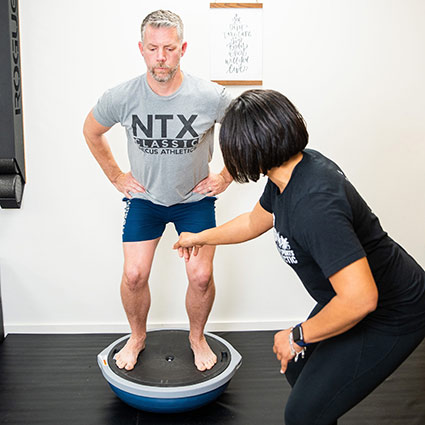 Though people are often not aware of it, balance is a fundamental part of all human movement. As we age, the ability to balance typically is compromised and lost over time. Maintaining the body’s ability to balance is crucial to overall health and well-being.
Though people are often not aware of it, balance is a fundamental part of all human movement. As we age, the ability to balance typically is compromised and lost over time. Maintaining the body’s ability to balance is crucial to overall health and well-being.
Why Does Balance Matter?
Balance is defined as an individual’s ability to control his or her center of gravity. It is integral to movement because it improves joint stability, internal focus, and the body’s ability to stabilize itself. It’s important to challenge the body’s balance system to keep it in good working order. Research also shows that balance training is highly effective in increasing confidence in older adults, optimizing performance, decreasing risk for injury, and enhancing rehab.
What Does Balance Training Involve?
Balance training involves exercises that focus on improving your ability to maintain your body’s equilibrium while standing or moving. It is a type of physical exercise that helps improve coordination, flexibility, and stability.
What Are the Main Benefits of Balance?
Balance training has many proven powerful benefits for the body including performance enhancement, injury prevention, and rehabilitation optimization.
Some ways balance creates better performance in the body include:
- Improved static and dynamic balance (standing still and while moving)
- Better brain-to-muscle (neuromuscular) communication, control and
- coordination in lower extremities
- Increased strength in the lower body (especially when combined with resistance training)
- Increased athletic power and agility
- Improved performance in athletes, such as vertical jump height
- Better ability to perform tasks for daily living in older adults
Balance can help prevent injury by:
- Improving mechanics for landing, reducing risk for lower extremity injuries, such as ankle sprains and ACL injuries
- Reducing the risk of falls
- Reducing self-reported injuries in older adults
Balance has been proven to optimize rehabilitative efforts by:
- Helping patients recover faster from injury
- Minimizing effects of muscle imbalance due to compensation from single limb injuries
- Increasing the body’s ability to orient itself in space (proprioception)
- Enhancing rehab of single limb injuries in athletes.
- Enhancing rehab to decrease falls in older adults
Frequently Asked Questions
What are some benefits of balance training?
What types of exercises should I do for balance training?
How often should I balance training?
Do I need any special equipment for balance training?
Schedule an Appointment
Regular balance training keeps your body in good working order and leads to a healthier you. Interested in learning how to incorporate balance training into your routine? Call us to book an appointment with our Corrective Exercise Specialist.
CONTACT US »
